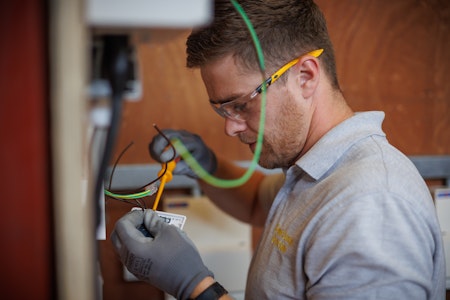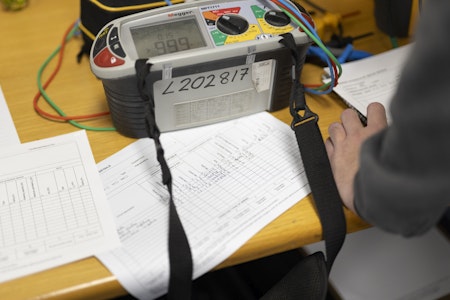Even with normal, appropriate use, electrical equipment and installations won’t last forever. Over time, wear and tear will inevitably occur, rendering the equipment and/or installation potentially hazardous or non-functional.
The trouble is, much of a home’s electrical system is hidden away in walls or shut in cupboards or enclosures. And, even where parts of an electrical installation are visible and accessible, it’s not always possible to know when a fault has developed.
That’s why it’s so important to have the installation in your home, rental property, or business premises regularly checked through an Electrical Installation Condition Report (EICR), ensuring everything’s in good working order and keeping everyone safe.

Firstly – what’s an electrical installation?
An electrical installation includes the system of wires, switches, socket-outlets and lighting that brings electricity from the main supply into your house and makes it usable. This includes:
- wires and cabling inside your walls, under your floors and above your ceilings
- consumer units or fuse boxes
- light fittings, switches and socket-outlets
- fixed electrical equipment such as showers
- protective devices including circuit breakers and RCDs (residual current devices).
In contrast, portable items that you plug into your socket-outlets (think, hairdryers, fridges, or TVs) are generally not considered part of the electrical installations – they’re appliances.
What is an EICR?
Also referred to as an electrical safety check, an Electrical Installation Condition Report (EICR) is a document produced by an electrical inspector following a comprehensive health check of your home’s or property’s electrical installation. You might also have heard of it referred to as ‘fixed wire testing’ or ‘periodic inspection and testing’.
An EICR will identify signs of age, wear and tear, and damage, ensuring your home’s electrical installation is safe to use and that you’re not at risk of fires or electric shocks resulting from faults in the electrical installation.
Do I have to get an EICR?
Rented properties - If you are a landlord renting out properties in the UK private rented sector, then yes, you must legally have your electrical installations inspected and tested by an electrical inspector at least once every five years. You must also provide your tenants with a copy of the report after it’s completed or soon after they move in.
From November 2025, social landlords in England will also become subject to these legal requirements for all new tenancies, with existing tenancies to be brought under the law in May 2026. Social landlords in Scotland and Wales are already subject to similar requirements.
Businesses
While there aren’t any specific laws on commercial EICRs, under the Electricity at Work Regulations 1989, businesses and employers must ensure that all electrical equipment in their building is safely maintained. Failure to comply with this legislation can lead to prosecution, with sanctions including fines.
Given that the easiest way to safely maintain electrical equipment is through regular electrical safety checks, it’s strongly recommended that business owners obtain an EICR at least once every five years. It’s also highly recommended that they carry out in-service inspection and testing of electrical equipment, (formerly known as Portable Appliance Testing or PAT testing), which involves the inspection and testing of electrical appliances like kettles, microwaves, printers and laptops.
Homes
If you own your own home, there aren’t any laws requiring you to obtain an EICR for your property.
However, it’s generally recommended (for example, by electrical safety charity Electrical Safety First) that you obtain an EICR at least once every 10 years.

What does an electrical safety check involve?
When undertaking an EICR, your electrical inspector will move through a four-step process:
1. Visual inspection
The first step is a visual inspection to spot obvious signs of damage or poor installation quality, including:
- cracks or wear and tear in socket-outlets or switches
- signs of overheating or burning
- outdated or damaged consumer units/fuse boards
- missing or broken equipment and enclosure covers
- incorrect labelling of circuits
- DIY alterations that may not meet regulations.
2. Testing of circuits
Using a range of specialist equipment, your electrical inspector will isolate parts of your installation and perform a defined range of tests on the wiring around the home.
This includes:
- Continuity testing: to check all wires are properly connected with no unintended breaks.
- Insulation resistance testing: to ensure all wires are properly insulated and there’s no risk of the insulation breaking down, resulting in potential faults or electric shock risks.
- Polarity testing: to confirm that live and neutral wires are correctly connected and that the circuit protective devices are correctly installed.
- Earth fault loop impedance testing: to verify that, if a fault occurs, the system will trip quickly to safely cut off the supply.
- RCD testing: to ensure that RCDs function as intended and that they trip quickly enough to avoid electric shock.
3. Recording the results
If any faults or issues are found, your electrician will note these down and assign each one a classification code:
- Code C1: danger present – immediate action required.
- Code C2: potentially dangerous – urgent remedial work needed.
- Code C3: improvement recommended – not dangerous but should be improved.
- FI: further investigation required.
4. Issuing the report
Following the inspection, the homeowner, landlord, or business will receive a full report on the electrical safety status of their home or property, listing any electrical faults diagnosed, their classification code, and recommendations of how to fix them.
EICRs are either satisfactory or unsatisfactory. If a C1, C2 or FI code is assigned to any observed issue, this will result in an unsatisfactory outcome.
Note that an FI classification code can be assigned to issues that are not necessarily faults. It can simply mean an unknown situation that needs further investigation to rule out a potential fault.
Do you need a professional to install an EICR test?
Yes – an EICR involves specialised electrical tests and equipment and should never be a DIY job.
Particularly for landlords, laws across the UK’s devolved nations require EICRs to be undertaken by a ‘qualified’, ‘skilled’, and/or ‘competent’ electrical inspector, meaning that you could be breaking the law if you don’t hire the right professional for the job.
An electrical business or sole trader, registered with a certification body such as NICEIC can be recognised on the UK competent person register for electrical inspectors. They’ll be subject to regular assessments to ensure their work continues to comply with all the latest electrical rules and regulations, and their electrical inspectors will have all the required qualifications, experience and skills to properly and safely inspect and test electrical installations.
To find a competent tradesperson for your next EICR report, look no further than NICEIC. Boasting one of the UK’s largest databases of registered electricians, you can find a competent electrical inspector to take care of all your EICR needs in just a few clicks.
The duration of an EICR check will vary depending on the size of your property and the size and complexity of your electrical systems. This can vary from a few hours for a small domestic property, to a full day or even multiple days for the largest residential, commercial or industrial premises.
Your chosen electrical inspector will be able to give you a time estimate based on your property and circumstances.
Just as it’s difficult to estimate how long an EICR test takes, the cost of an EICR will also vary drastically according to factors like the size of your property, the scale and complexity of your property’s electrical systems, and what your chosen electrical inspector typically charges to carry out an EICR.
Using NICEIC’s Find a Trusted Tradesperson tool, you can find registered electrical inspectors near you who are certified to carry out EICRs, and request a quote from a number of different providers. By comparing several quotes, you can get a better understanding of what an EICR will cost for your particular property and hire a competent, registered electrical inspector at a price that is acceptable to you.
So, an Electrical Installation Condition Report (EICR) and an Electrical Installation Certificate (EIC) are two different things.
You’ll get an EIC after an electrician has completed any new installation or major alteration to an installation on your property. It provides important details about the installation, including the results of initial testing of the completed work, to confirm the new work is safe, and that it complies with all relevant regulations at the time of installation.
An EICR, on the other hand, is a report that checks existing installations to confirm they are still working safely and that there’s no risk of electric shocks or fires.
If you’re a landlord, your EIC for any new installation will be valid for five years, after which you’ll need to get an EICR to ensure the installation is still safe to use and in good working order.
Yes, the domestic rented rules around EICRs differ among the four devolved nations of the UK: England, Wales, Scotland and Northern Ireland.
Take a look at the table below to understand what the laws are where you are.
|
|
England |
Wales |
Scotland |
Northern Ireland |
|
Domestic private rented EICRs must be carried out ... |
Every five years |
Every five years |
Every five years |
Every five years |
|
Does law include social rented sector? |
Yes – from November 2025 |
Yes |
Yes |
No |
|
Copies of EICRs must be given to new tenants... |
Within 28 days of moving in |
Within 14 days of moving in |
Before the tenancy starts |
Within 28 days of moving in |
|
Copies of EICRs must be given to existing tenants... |
Within 28 days of completion of the EICR |
Within 14 days of completion of the EICR |
Following the inspection |
Within 28 days of completion of the EICR |
|
Written confirmation of any remedial works must be given to tenants … |
Within 28 days of completion of the works |
Within 14 days of completion of the works |
Unspecified |
Within 28 days |
|
Is Portable Appliance Testing (PAT) legally required? |
Yes, in social rented properties starting in November 2025 for new tenants and May 2026 for existing tenants |
No |
Yes |
No |
All information shared is correct as of September 2025.
